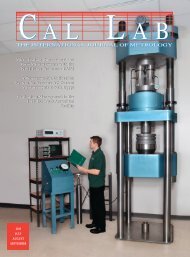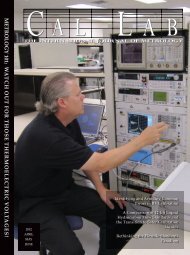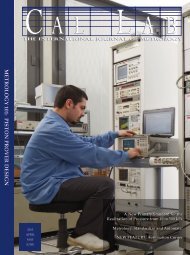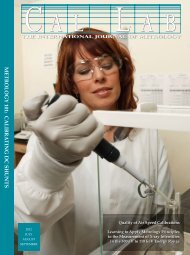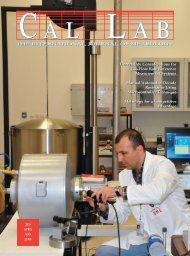Magazine – PDF - Cal Lab Magazine
Magazine – PDF - Cal Lab Magazine
Magazine – PDF - Cal Lab Magazine
You also want an ePaper? Increase the reach of your titles
YUMPU automatically turns print PDFs into web optimized ePapers that Google loves.
vessel; this comparator can weigh an artifact in the usual<br />
way in the vacuum vessel, but can also weigh an artifact<br />
in the atmospheric pressure chamber by connecting the<br />
comparator to the artifact across the air vacuum boundary<br />
via magnetic levitation. This is illustrated in Figure 6.<br />
The complete scenario of calibrating a mass standard<br />
in a watt balance under vacuum, transporting it under<br />
vacuum to the magnetic levitation system, and then using<br />
the magnetic levitation system to transfer the vacuum<br />
Figure 6. Illustrations of vacuum to air transfer of kilogram<br />
calibration using magnetic levitation. The top illustration shows<br />
a standard mass in the vacuum chamber being compared to<br />
a mass in the air chamber using the same mass balance. The<br />
bottom illustration shows the levitation of a mass artifact; the upper<br />
magnetic pole is connected to the mass balance.<br />
An Introduction to Mass Metrology in Vacuum<br />
Patrick J. Abbott, Zeina J. Jabbour<br />
calibration to a mass artifact in air is shown in Figure 7.<br />
This represents a possible method of disseminating the<br />
new SI definition of the kilogram to national laboratories,<br />
which then pass it on to the mass community through<br />
conventional mass metrology in air. It must be emphasized<br />
that all of these steps will be transparent to the mass<br />
metrology community that relies on calibration of primary<br />
standards by national laboratories. There will be no change<br />
in procedures or quality of calibrations as a result of the<br />
new SI kg definition.<br />
Conclusions<br />
We have reviewed vacuum technology design<br />
considerations that are germane to mass measurement<br />
in vacuum and recommend the following: 1) Based on<br />
the need to minimize the air buoyancy correction of the<br />
mass measurements a maximum chamber pressure of 0.1<br />
Pa should be used for mass metrology. Other factors,<br />
such as the amount of water adsorbed onto mass artifacts<br />
may dictate that a working pressure lower than 0.1 Pa be<br />
used. 2) Scroll pumps are a good choice for initial rough<br />
pumping of a vacuum chamber as well as backing a high<br />
vacuum pump. They are oil-free, competitively priced<br />
and comparable in performance to oil-sealed rotary vane<br />
pumps. 3) Turbomolecular drag pumps are the best option<br />
for producing high vacuum for mass metrology. They are<br />
clean, come in a variety of pumping speeds, and enable the<br />
use of oil free backing pumps. 4) A convection enhanced<br />
Pirani gauge is economical and sufficiently accurate for<br />
measuring pressure from atmospheric pressure to 10 Pa<br />
during initial chamber evacuation. For measuring pressure<br />
below 10 Pa, a calibrated capacitance diaphragm gauge<br />
offers the necessary accuracy, has good stability, and is<br />
contaminant-free. A 133 Pa, full scale calibrated CDG can<br />
accurately measure pressures down to 10 -3 Pa with an<br />
expanded uncertainty of less than 1%.<br />
Realizing the new SI definition of the kilogram involves<br />
a transfer of an artifact’s mass as measured in vacuum to<br />
atmospheric pressure air. The two are different due to the<br />
adsorption of contaminate molecules, mostly water, onto<br />
the mass artifact in air. NIST is working on a new method<br />
of bridging the vacuum to air boundary using a magnetic<br />
levitation technique that uses the same high precision mass<br />
comparator to weigh artifacts in vacuum and air.<br />
Acknowledgements<br />
It is a pleasure to acknowledge Rick Seifarth of the<br />
Mass and Force group at NIST and Jay Hendricks of the<br />
Pressure and Vacuum group at NIST for critical readings<br />
of this manuscript and for offering suggestions for its<br />
improvement. We are also indebted to Dr. Bruce R.F.<br />
Kendall, Professor Emeritus at The Pennsylvania State<br />
University, for many years of teaching and discussions<br />
related to vacuum technology.<br />
Oct • Nov • Dec 2011 33 <strong>Cal</strong> <strong>Lab</strong>: The International Journal of Metrology



